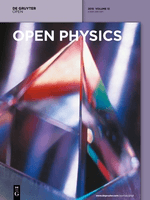
Open Physics
Scope & Guideline
Exploring the universe of physics, freely accessible to all.
Introduction
Aims and Scopes
- Thermal and Fluid Dynamics:
The journal frequently publishes studies on heat transfer, fluid mechanics, and nanofluid dynamics, focusing on both theoretical models and experimental validations. - Mathematical Physics and Modeling:
A significant portion of the articles involve advanced mathematical modeling techniques, including fractional calculus, stochastic differential equations, and nonlinear dynamics, used to solve complex physical problems. - Magnetohydrodynamics (MHD):
Research related to MHD is a core area, exploring the behavior of electrically conducting fluids under magnetic fields, with applications in engineering and astrophysics. - Nanotechnology and Materials Science:
The journal showcases research on the properties and applications of nanomaterials, including their thermal and mechanical behaviors, and interactions with various physical forces. - Optics and Photonics:
Open Physics features studies on optical phenomena, including soliton dynamics and laser applications, contributing to advancements in optical communication and imaging. - Biophysics and Medical Physics:
There is a growing focus on biophysical applications, particularly in modeling biological systems, medical imaging, and treatment methodologies, reflecting the interdisciplinary nature of modern physics.
Trending and Emerging
- Fractional Calculus Applications:
There is a rising interest in fractional calculus and its applications across various fields, including fluid dynamics and epidemic modeling, indicating a trend towards more sophisticated mathematical frameworks. - Nanofluid Dynamics:
Research on nanofluids, particularly their thermal and flow characteristics, is increasingly prominent, reflecting the growing importance of nanotechnology in engineering applications. - Machine Learning and AI in Physics:
The integration of machine learning techniques for solving complex physical models and optimizing processes is gaining traction, pointing to a trend towards computational physics and data-driven research. - Bioconvection and Microbial Interactions:
Emerging studies on bioconvection and the dynamics of microorganisms in nanofluids highlight the intersection of biology and physics, showcasing innovative approaches to understanding ecological and biomedical systems. - Optoelectronics and Photonic Applications:
The journal is seeing a surge in papers related to optoelectronic devices and their applications, emphasizing the relevance of optical technologies in modern physics.
Declining or Waning
- Classical Mechanics:
Research articles focusing solely on classical mechanics principles are becoming less common, as the journal shifts towards more complex and interdisciplinary applications involving advanced materials and nanotechnology. - Basic Theoretical Physics:
While foundational theoretical physics remains important, there has been a noticeable decrease in papers that do not incorporate modern methodologies or applications, leading to a trend towards more applied and computational studies. - Traditional Energy Systems:
Research on traditional energy systems, such as fossil fuels and basic thermodynamics, is waning as the journal emphasizes renewable energy technologies and their integration with advanced materials.
Similar Journals
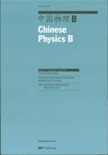
Chinese Physics B
Illuminating the path of scientific discovery in physics.Chinese Physics B, published by IOP Publishing Ltd, is a distinguished journal in the field of Physics and Astronomy, offering a platform for researchers to disseminate cutting-edge studies and advancements. With an ISSN of 1674-1056 and an E-ISSN of 2058-3834, this journal emphasizes open access, ensuring that groundbreaking research is readily available to a global audience. Reflecting its commitment to quality, Chinese Physics B is categorized in the Q3 quartile (2023) in its subject area and ranks 118 out of 243 among its peers in general physics and astronomy according to Scopus, placing it in the 51st percentile. Publishing since 2008, the journal not only maintains a rigorous peer-review process but also aims to foster collaboration among academics in various physics disciplines. With its base in the United Kingdom, Chinese Physics B remains a crucial resource for those seeking to stay abreast of developments in the diverse world of physics.
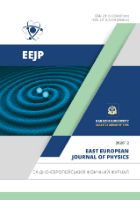
East European Journal of Physics
Exploring the frontiers of Eastern European research.The East European Journal of Physics, published by the V N Karazin Kharkiv National University, is a dynamic open-access journal dedicated to advancing research in the fields of Physics and Materials Science. Since its inception in 2014, the journal has become a platform for scientists and academicians throughout Eastern Europe and beyond, fostering collaboration and dissemination of innovative studies and findings. With its ISSN 2312-4334 and E-ISSN 2312-4539, it attracts a global readership and submissions that are rigorously peer-reviewed to ensure the highest scholarly standards. Despite currently holding a Q4 category ranking in both Materials Science and Physics and Astronomy, as well as modest Scopus rankings, the journal is positioned to play a crucial role in elevating the visibility and impact of research emanating from this geographically and scientifically significant region through an open access model. This commitment to open scholarship is critical for fostering academic exchange and impact, making the East European Journal of Physics a valuable resource for researchers, professionals, and students seeking insight into the latest developments within these fields. Join us in exploring the frontiers of knowledge and innovation from Ukraine and its surrounding areas.

BRAZILIAN JOURNAL OF PHYSICS
Pioneering Discoveries in Brazilian PhysicsBRAZILIAN JOURNAL OF PHYSICS, published by SPRINGER, is a prominent platform dedicated to the dissemination of research within the realm of physics and astronomy. With an ISSN of 0103-9733 and E-ISSN of 1678-4448, this esteemed journal has been contributing to the field since its inception in 1996, and it continues to be pivotal in showcasing innovative studies and breakthroughs. The journal is categorized in the Q4 quartile for the year 2023, reflecting a dedicated focus on advancing knowledge across a variety of disciplines, particularly in general physics and astronomy, where it ranks 126th out of 243 in Scopus rankings. Although it currently does not operate under an open-access model, it remains an invaluable resource for researchers, professionals, and students eager to enhance their understanding of complex physical principles and developments. The journal is committed to promoting high-quality research, bridging gaps in knowledge, and fostering collaboration within the global physics community.

Communications in Analysis and Mechanics
Pioneering open access to cutting-edge research and methodologies.Communications in Analysis and Mechanics is a pioneering journal published by the AMER INST MATHEMATICAL SCIENCES (AIMS), dedicated to advancing the fields of mathematics, engineering, and applied sciences. With its recent transition to Open Access in 2023, the journal aims to enhance the dissemination of high-quality research by fostering a collaborative environment for researchers, professionals, and students. Operating from the United States, this journal embraces a broad scope encompassing geometry, optimization, and mechanics, ensuring a comprehensive platform for innovation and critical discourse. Despite its nascent status, it features competitive Scopus rankings in various disciplines, notably achieving a percentile around 7th to 13th, indicative of its growing impact among peers. The editorial team is committed to publishing original research that addresses significant challenges and developments within the mathematical sciences, facilitating a vital exchange of ideas and methodologies.

Magnetohydrodynamics
Advancing Knowledge in Magnetohydrodynamic ApplicationsMagnetohydrodynamics, published by the University of Latvia Institute of Physics, stands as a crucial repository of knowledge within the realms of Electrical and Electronic Engineering and Physics and Astronomy. With its roots extending back to 1970, this journal offers an extensive archive of scholarly articles focusing on the dynamics of electrically conducting fluids, an area of increasing relevance in both theoretical and applied physics. Although the journal currently does not operate under an open-access model, it provides valuable insights that continue to impact ongoing research and technological advancements in magnetohydrodynamic applications. Its prestigious standing is reflected in its Q3 category rankings within both specified fields and its significant position within the Scopus rankings, marking its importance for professionals and researchers alike. As the journal reaches the convergence years culminating in 2024, readers can expect a rich anthology of pioneering studies and developments that bridge the gap between fundamental research and its practical implications.
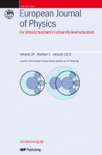
EUROPEAN JOURNAL OF PHYSICS
Fostering Dialogue in the World of PhysicsEuropean Journal of Physics, published by IOP Publishing Ltd, is a premier international journal serving the diverse field of physics and astronomy. With a commitment to advancing scientific knowledge since its inception in 1980, the journal provides a platform for original research articles, reviews, and topical discussions in various domains, including theoretical and experimental physics. Operating out of the United Kingdom, the journal has achieved a commendable Q2 ranking in the Physics and Astronomy (miscellaneous) category for 2023, reflecting its robust influence in the academic community, alongside a notable Scopus Rank that underscores its relevance in both the Social Sciences and General Physics and Astronomy fields. Although it does not currently offer open access, the journal's traditional publication model ensures rigorous peer review, maintaining high scholarly standards that are imperative for researchers, professionals, and students striving to stay ahead in their respective fields. Don't miss the opportunity to engage with cutting-edge research and contribute to the ongoing dialogue in physics by accessing this vital resource.
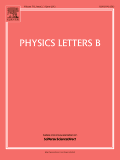
PHYSICS LETTERS B
Advancing the Frontiers of Nuclear PhysicsPHYSICS LETTERS B, published by Elsevier, is a leading open-access journal in the field of Nuclear and High Energy Physics, with a notable history dating back to 1967 and a commitment to disseminating high-quality research through to 2024. With an impact factor that places it in the Q1 category, ranking 7th out of 87 journals in its subfield (92nd percentile), it serves as an indispensable platform for researchers seeking to share groundbreaking findings and engage with cutting-edge developments. The journal's open-access policy since 2014 ensures that knowledge is widely accessible, fostering collaboration and innovation within the global scientific community. Located in the heart of Amsterdam, the journal not only supports a vibrant discourse among physicists but also contributes significantly to advancing the frontiers of nuclear and high-energy research, making it an essential resource for researchers, professionals, and students alike who are dedicated to shaping the future of physics.

Science China-Physics Mechanics & Astronomy
Unlocking the Secrets of the UniverseScience China-Physics Mechanics & Astronomy, published by SCIENCE PRESS, stands as a prestigious journal within the Physics and Astronomy domain, particularly recognized for its contributions to the understanding of fundamental and applied physics. With an exhilarating Q1 ranking in the 2023 category and earning a remarkable scopus rank of #21 out of 243, the journal demonstrates its significant impact, being positioned in the 91st percentile of its field. Operating under an Open Access model, it facilitates the broad dissemination of high-quality research, ensuring accessibility for researchers, professionals, and students worldwide. Its scope covers a variety of essential topics in physics and astronomy, promoting a comprehensive understanding of the latest advancements from 2010 through 2024. The journal is a vital resource for anyone aiming to stay at the forefront of research in these dynamic fields, with its prominent address located in Beijing, China, symbolizing its global influence.
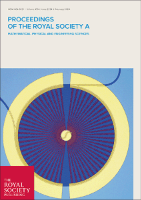
PROCEEDINGS OF THE ROYAL SOCIETY A-MATHEMATICAL PHYSICAL AND ENGINEERING SCIENCES
Championing Quality Research in the Heart of Scientific Inquiry.PROCEEDINGS OF THE ROYAL SOCIETY A-MATHEMATICAL PHYSICAL AND ENGINEERING SCIENCES is a prestigious academic journal published by the Royal Society in the United Kingdom, dedicated to the dissemination of high-quality research in the fields of Mathematics, Engineering, and Physics. With an esteemed impact factor and ranked in the top quartiles (Q1) across various categories, this journal stands out as a leading source of innovative findings and critical discussions within the global scientific community. Researchers benefit from its comprehensive coverage that spans from theoretical explorations to practical applications, and the journal plays a crucial role in advancing knowledge and fostering interdisciplinary collaboration. Although it does not currently offer Open Access options, its influence is underscored by notable Scopus rankings, evidencing its significant contribution to the fields it represents. Located at 6-9 Carlton House Terrace, London SW1Y 5AG, England, the journal continues to be a cornerstone for scholars seeking to publish impactful research and stay informed on the latest advancements in science and engineering.

International Journal of Fluid Mechanics Research
Unraveling the Complexities of Fluid DynamicsThe International Journal of Fluid Mechanics Research, published by BEGELL HOUSE INC, is a pivotal platform for the dissemination of innovative research within the fields of Mechanical Engineering and Physics. With a focus on the intricate dynamics of fluid behavior, this journal has been a cornerstone of scholarly communication since its inception in 1996, continuing to engage a global audience of researchers and professionals through to 2024. With a respectable Impact Factor reflecting its significant contributions to the disciplines—ranking in Q3 for both Mechanical Engineering and Miscellaneous Physics and Astronomy categories—this journal presents a unique opportunity for authors to share their findings in a peer-reviewed environment. Although it does not currently offer Open Access options, all published articles are carefully curated, ensuring high-quality research is accessible to its readership. As the journal navigates the complexities of fluid mechanics, it fosters an interdisciplinary dialogue, bridging theoretical frameworks with practical applications, thereby enhancing understanding and innovation in related fields.